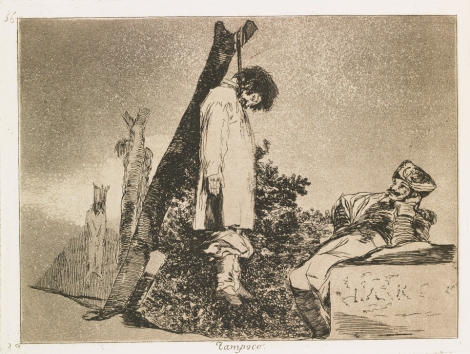
By Will Abbott
Francisco Goya (1746-1828) is considered to be the most important Spanish painter of the eighteenth and nineteenth centuries for his contribution to commentarial art – the summa of which, The Disasters of War, is currently on display in The Chester Beatty Library. They describe the prints of Francisco Goya’s secret protest at Napoleon’s 1808 invasion of Spain currently on display there as “the predecessors of modern photojournalism”. Indeed, it’s hard not to draw comparisons with the now-iconic images captured during, say, the Vietnam War. While these etchings may not compare with the accuracy offered by film, they offer a chilling insight into the horrors of war that few polaroids could ever hope to achieve.
The prints are categorized into 3 sections. War focuses on the dehumanising effects of armed conflict; the devastation caused by the rape and pillaging of an invading army, the desperation of civilians attempting to ward them off, and the grotesque fates that await those who fail. It features some of the most disquieting images of the entire series. Enterrar y callar (Bury them and keep quiet) brings to mind Michael Longley’s “landscape of dead buttocks” from his poem Wounds; the loss of simple dignity becoming almost surreal.
‘Famine’ casts its gaze to the famine in Madrid; a direct result of the invasion. Despite being based on this specific event, any of the images could easily represent the grief of the survivors from the previous set of tableaus; ‘Las camas de la Muerte (The beds of death)’ is an especially haunting portrayal of massive loss of life.
While these etchings may not compare with the accuracy offered by film, they offer a chilling insight into the horrors of war that few polaroids could ever hope to achieve.
Caprices is an allegorical take on the post-war period. Here the metaphorical becomes real, and civilians are subject to the whims of demons and beasts. These images are given additional weight by those that precede; it elevates them from a typical political cartoon to an anguished wail against the sheer scale of injustice.
Many of the titles given to the prints are ironic, or give into the despair shown in the images – with the title of a cruel depiction of the hanging of a civilian, simply translating as Why?. Many prints focus solely on the victims and the suffering they are forced to endure. Often only a lone victim is in focus, with those in the background obscured in shade and in shadow. Two prints take this approach to its logical extreme, by featuring only the tips of the perpetrator’s guns (with those who pull the trigger conspicuously absent).
In the final pair of prints, Goya mourns what is often the first victim of war, truth itself. This collection, and subsequently this exhibition, however, shows the power of the human to withstand hardship as he has managed to preserve the truth of the atrocities of war. Such perseverance remains an important quality for viewers of the exhibition to take away with them in this day and age.
This free exhibition continues in the Chester Beatty Library until the 21 January 2018.